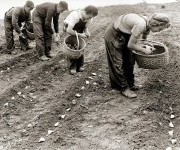 Photo courtesy of the USDA archivesTucked into the end of a recent New York Times article about young farmers were two frank paragraphs about a quiet reality many of us face:
Photo courtesy of the USDA archivesTucked into the end of a recent New York Times article about young farmers were two frank paragraphs about a quiet reality many of us face:
Ms. Oakley said young farmers rarely discussed that lack of community, adding that she had seen the isolation break up marriages. At their Three Springs Farm, she and her husband, both 34, grossed $60,000 by their third season — a reason to celebrate by most standards — but they wished they had more company.
Secure · Tax deductible · Takes 45 SecondsSecure · Tax deductible · Takes 45 Seconds“It was just the two of us, every job we did together,” Ms. Oakley said. “It’s intense. We would gladly trade a little competition for more community and collaboration.”
Amen! As a young, very extroverted part-time farmer who didn’t grow up in a small town, I’d do just about anything for more of a sense of community.
Not only do farmers rarely discuss the isolation they face, but consumers and advocates who want to see more small, sustainable farmers on the land rarely talk about what it will take to build the kinds of communities where farmers want to live.
Picture in your mind the perfect farm, the farm where you would like your food to be grown. It’s a place that reflects all the values you hold dear. Feel the sun on your face; maybe there’s a slight breeze in your hair. Notice what plants are growing there, the vegetables and fruits and herbs that you love. Smell the rich, wet soil. Hear the birds in the trees or on the ground. Look in the face of the farmer. You know that she doesn’t use synthetic pesticides or inject her animals with hormones. She’s also making a living wage, has access to health care, and she can pay her workers a living wage too.
Now picture the community your farmer lives in. Picture the people that she is surrounded by, the neighbors he sees every day. Listen to the sound of the vibrant businesses in the place where she lives, feel the support and security that your farmer feels. Visit the school her children attend, the grocery store, and the cafe where she sells her products. Notice that the community nourishes her with positive support, just as the farmer provides the community with healthy food.
Sounds pretty good, don’t you think?
Unfortunately, most farmers don’t live in a supportive, idyllic community like the one you just pictured. In reality, producing food can be lonely. If you’re farming in a manner different from all your neighbors, it can even be alienating. Not to completely romanticize “the way things used to be,” but there were a lot more families here — in Nebraska, and all over rural America — 50 to 60 years ago. I drive by towns that once had several hundred people, a post office, and a school; now there are only a few houses left. Everything else has been bulldozed to plant corn. People were lonely then too, but at least there were a handful of other people there canning food or tending livestock, and you could do these things together.
If we’re going to bring 100,000 new farmers onto the land, as Agriculture Secretary Tom Vilsack has suggested, we’ll need more people who are willing to step up and grow our food. Whether they live in urban, rural, suburban, or frontier places, farmers need to know they’re part of a web of other people who care about and value their work. Even those of us who lean towards fierce independence want to know we’re not alone.
I live five miles outside a town of 850 people that could be more vibrant, more open to my ideas and goals as a farmer. I know that the customers who buy our eggs and lamb appreciate the work I do to make the food they eat, but I don’t see them every day. (In fact, because I sell at an online farmers market, I rarely see any of my customers at all.) There are one or two other farmers in the area who grow things like we do, but we see them about every other month. Folks in my town are nice people, but they generally see nothing wrong with chemical farming or genetically modified seeds, as far as I can tell. Rarely does anyone think that farming without these technologies might be worth something extra. We stand by our values and practice sustainable agriculture, but pay the price of being seen as outsiders.
Growing food can be fun and rewarding. But for me, and many others like me, much of the enjoyment slips through my fingers like soil if there’s no one to share it with.
So what can you do? At the time of year when everyone is contemplating thankfulness, one place to start is with the farmers in your life. Find out what kind of community they live in, and what you could do to help them feel more nourished. Smile when you see them. Write them a thank-you card, make them a gift, or express in some other way that you appreciate their hard work. You might think of them every time you eat their products, so why not give them something that will remind them just as often that their customers are grateful? Bring as much joy to their lives as they bring to yours with the food they grow. Perhaps you’ll find that by building your farmer’s community, your own community is strengthened too.




